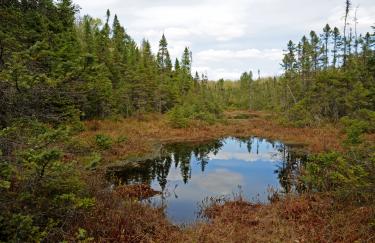Where are Best Management Practices Important in my Woodland?
Managing with soil and water in mind is important throughout your woodland, and will lead to a healthier more productive and sustainable family forest.
But you will want to pay careful attention to protection around water bodies. Lakes, streams and wetlands perform countless valuable services in a forest: from their immeasurable beauty, to essential resources and homes for wildlife, to flood protection and the maintenance of water quality. In order to protect these watery havens, it may help to get better acquainted with them. Each type of water body has unique characteristics and protections you’ll want to consider. We’ll talk about the three main types you may have on your woodland.
Lakes
Water bodies that are generally permanent and have a defined bed and bank are called lakes. This category includes small ponds less than an acre in size, as well as large lakes spanning hundreds of acres, and everything in between. The water level in lakes may fluctuate depending on the season, and during prolonged droughts they may even dry up, but in general, lakes are permanent water bodies with well-defined boundaries.
Best Management Practices for lakes include preserving a forested or vegetated buffer called a Riparian Management Zone around the perimeter of the lake to ensure water quality and provide important wildlife habitat. Lakes can become polluted when roads or trails are situated too close to the shoreline and runoff and erosion send soil and other pollutants into the water. Any construction on a lakeside has the potential to damage these water bodies.
Streams
Waterways that have a defined channel and banks are called streams. Some streams flow all year round, while others are seasonal and only appear during rainy seasons or during periods of snowmelt. The integrity of the land surrounding streams plays an important role in stream health. Plants that live along streams provide shading and keep temperatures down, and their fallen leaves provide nutrients for aquatic insects, all of which is important for many fish species. Streamside vegetation also helps protect soil so that it stays in place rather than eroding off into waterways.
Best Management Practices for streams include protective zones called Riparian Management Zones that keep streamside ecosystems intact. As well, forest roads, stream crossings, landings and skid trails can have damaging impacts on streams if they are not designed according to Best Management Practices.
Wetlands
Wetlands are areas at the edges of streams and lakes, in lowland depressions, or around seeps and springs, which support very moist conditions, standing water or saturated ground for long periods–long enough to foster water loving plants like marsh marigolds, tag alders and cattails. They don’t necessarily hold water all year round, and some only stay saturated for a few weeks every other year. But they develop special soil conditions that support unique communities of plants and wildlife. There are many different types of wetlands defined by their plant communities and water and soil characteristics. They range from ephemeral ponds to hardwood swamps and all are vulnerable to intensive forest practices.
When possible, avoid disturbing wetlands and the area around them. Timber harvesting, construction and vehicular travel through wetlands can cause irreparable damage to these fragile ecosystems. If activity in wetlands is necessary, work should be restricted to dry periods or cold winter months when the ground is frozen and less vulnerable to rutting and other disruptions to soil, vegetation and water flow. By limiting work in wetlands to winter months, you will also avoid disturbing nesting birds, which may have homes within wetland vegetation during warmer months.
How can I get more tips?
It’s simple! Enter your email below.

